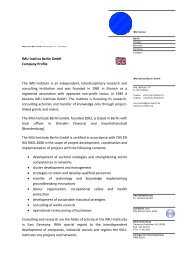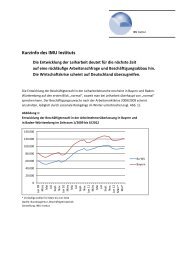Aufzüge und Fahrtreppen - IMU Institut
Aufzüge und Fahrtreppen - IMU Institut
Aufzüge und Fahrtreppen - IMU Institut
Erfolgreiche ePaper selbst erstellen
Machen Sie aus Ihren PDF Publikationen ein blätterbares Flipbook mit unserer einzigartigen Google optimierten e-Paper Software.
The competitive pressure to which the<br />
lift and escalator industry is exposed in<br />
both the international and the national<br />
arena is enormous. Aggressive competitive<br />
strategies and tough price-cutting<br />
polices have resulted in a signifi cant collapse<br />
of pricing levels over recent years<br />
for companies in all three main business<br />
sectors: New installations, modernization<br />
and now also repairs and maintenance.<br />
Many medium-sized lift construction<br />
companies in particular do not have<br />
the capacity to withstand predative competition,<br />
which alongside other factors<br />
not infrequently results in a takeover bid<br />
and integration into one of the Big 4.<br />
Seen overall, there is an unmistakable<br />
trend towards the concentration of the<br />
German lift market, where company buyouts<br />
have effectively concentrated the<br />
range of goods and services on offer over<br />
recent years.<br />
Growth and competition in the<br />
service sector<br />
Service orientation within the lift and escalator<br />
sector is very high, for manufacturing<br />
in general, and for the mechanical<br />
engineering sector in particular. Many<br />
companies operating in the sector have<br />
long since adopted a policy of offering<br />
customers the complete spectrum from<br />
the industrially manufactured or manually<br />
crafted product through to servicing.<br />
Linking products and services is becoming<br />
an ever more important trend among<br />
mechanical engineering fi rms and a<br />
number of other sectors of industry in<br />
Germany. The lift industry may claim to<br />
be something of a pioneer in a mechanical<br />
engineering industry characterized by<br />
a growing orientation towards the service<br />
sector; it has been a precursor in the<br />
shift of classical branches of industry<br />
away from manufacturer to service provider.<br />
As long as 20 years ago, Johannes<br />
Schmitt, today the CEO of Schmitt &<br />
Sohn, entitled his dissertation “Development<br />
in the Lift Sector from Manufacturer<br />
to Service Provider” (Schmitt 1988).<br />
Services represent a powerful growth area<br />
within the industry. The “Repair of lifts<br />
and escalators” has only been captured<br />
by the production statistics since 2002,<br />
but in the brief interval of just three years<br />
since these statistics have been recorded,<br />
the proportion of total production accounted<br />
for by services has leapt from<br />
36 % to 48 %. This statistic also refl ects<br />
the high strategic signifi cance of the expanding<br />
service business for lift constructors.<br />
Development within the industry is<br />
primarily dependent on building investment<br />
and is subject to cyclical fl uctuations.<br />
New installation business was <strong>und</strong>er<br />
pressure up until 2005 due to slug-<br />
gish investment activity, while the ever<br />
more important service sector remained<br />
relatively resistant to cyclical economic<br />
pressure. It was particularly during the recent<br />
crisis period of the building industry<br />
up until 2005, in other words when demand<br />
was suppressed, that the service<br />
sector emerged as an essential mainstay<br />
for beleaguered manufacturers to compensate<br />
for loss of earnings from new installations.<br />
Taken overall, the service sector<br />
is largely resistant to cyclical economic<br />
pressures, and to date has also proven<br />
fi nancially more lucrative for the companies<br />
involved. Consequently, producers<br />
are frequently willing to compromise on<br />
price for sales of new lift and escalator installations,<br />
provided the deal includes a<br />
long-term service contract. However,<br />
since 2005 prices in the service sector<br />
have also been subject to immense competitive<br />
pressure, serving to also the<br />
shrink contribution margins to be gained<br />
from maintenance contracts. This development<br />
is placing the policy of subsidizing<br />
new installation business (to gain access<br />
to lucrative maintenance contracts)<br />
increasingly <strong>und</strong>er question as a business<br />
strategy for producers.<br />
The overriding strategic aim of the Big 4<br />
can be neatly summarized by the term<br />
“growth”. Each of the four corporations<br />
aims to grow its service business faster<br />
than its competitors and to increase the<br />
number of maintenance contracts it<br />
holds. This is expressed in corporate directives<br />
and strategies such as “Leadership<br />
through Service” (Schindler), “1st in<br />
Service” (Otis), “Global Service Strategy”<br />
(ThyssenKrupp) and “VISION” (Kone).<br />
It is practically only possible to gain market<br />
share in the lift and escalator sector<br />
by company takeovers. The most important<br />
growth strategy is consequently the<br />
acquisition of other lift constructors and<br />
their maintenance contracts.<br />
Other SMEs<br />
32 %<br />
OSMA<br />
3 %<br />
Schmitt+Sohn<br />
5 % Kone<br />
9 %<br />
Diagram: Lift and escalator service business in Germany<br />
Over recent years, the emphasis of this<br />
acquisition strategy has been on the<br />
growth markets in Eastern Europe and<br />
Asia, although all of the Big 4 have also<br />
acquired a number of SMEs in Germany.<br />
The big players in the industry have been<br />
pursuing this strategy already for some<br />
time, and it seems set to be stepped up<br />
again over the coming years.<br />
One strategic area of particular signifi -<br />
cance in the service sector is that of socalled<br />
third-party maintenance. A core element<br />
of this new and expansive service<br />
strategy lies in contracts to service lifts<br />
from other manufacturers. For installers<br />
and fi tters, maintaining older lift installations<br />
from other manufacturers is largely<br />
troublefree, as this work involves primarily<br />
mechanical components, while more<br />
recent installations present more of a<br />
problem due to their use of “closed control<br />
systems” which only authorized staff<br />
of the original manufacturer can access.<br />
But even these systems can be “cracked”<br />
using technical means by competitors:<br />
The training centres of the Big 4 selectively<br />
train installers in the workings of<br />
third party control systems. Alternatively,<br />
the maintenance company retrofi ts its<br />
own components. At the same time,<br />
third-party maintenance agreements are<br />
simplifi ed by the fact that large-scale clients<br />
tend to specify the use of standardized<br />
control systems which are freely<br />
available for purchase on the open market<br />
in order to retain a greater degree of<br />
fl exibility in the placement of maintenance<br />
contracts. In practice, the range of<br />
third-party maintenance contracts on offer<br />
represents something of a minefi eld<br />
for sales departments, in spite of the dedicated<br />
training courses now on offer and<br />
aggressive marketing campaigns making<br />
use of different marketing tools such as<br />
mail shots and cold calling campaigns.<br />
Not only the Big 4 but also SMEs from the<br />
lift construction sector are leaning ever<br />
Actual status 2006 2010 – Growth scenarios of the Big 4<br />
Schindler<br />
22 %<br />
ThyssenKrupp<br />
12 %<br />
Source: Company data and <strong>IMU</strong> estimates<br />
34 LIFT-REPORT 33. Jahrg. (2007) Heft 6<br />
Otis<br />
17%<br />
OSMA<br />
3 %<br />
Schmitt+Sohn<br />
5 %<br />
Other SMEs<br />
22 %<br />
Kone<br />
12 %<br />
ThyssenKrupp<br />
15 %<br />
Schindler<br />
24 %<br />
Otis<br />
19%
















